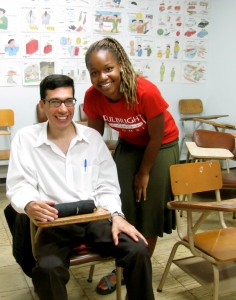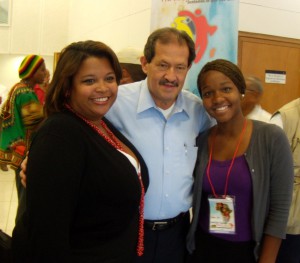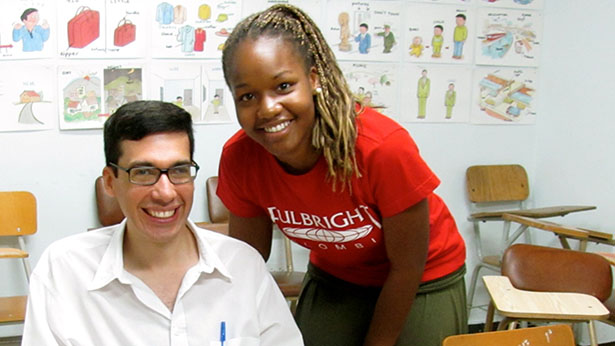
Emma Din, 2011-2012, Fulbright ETA to Colombia, giving individualized help to an advanced English student, Alex, who has been attending Fulbright ETA classes for four years
This was it: Thursday night at Tin Tin Deo. I was embracing la vida caleña, or Cali lifestyle, venturing into the “salsa capital of the world” by visiting the legendary salsa bar for the first time. I couldn’t have imagined it more perfectly with its low ceiling, pictures of famous salsa singers displayed on all the walls, dim lights, pulsing rhythms, and sultry atmosphere. I’d taken salsa classes before moving to Colombia and loved them, so I thought I was good to go. Little did I know, Cali-style salsa features quick footwork, unique Afro-influence, and enough improvisation to render the classic movements and foot patterns I’d learned useless; I was forced to give up on the prescriptive combinations and rely instead on how the music made me feel and what my partner was communicating with his steps. That night, I discovered that in Cali, Colombia, salsa is more than a fun activity, more than a sport, and more than an art form; it is an identity and language.
My time spent practicing salsa outside of class influenced my role inside the classroom as a Fulbright English Teaching Assistant (ETA). I was placed at the Universidad Santiago de Cali and had my own classroom where I assistant taught English conversation classes to college students ranging from 15 to 50 years old. Just as I was learning the importance of moving away from memorized salsa steps, I challenged my students to step away from the prescriptive English sentences and dialogues they had memorized. I encouraged them to take risks and to get outside of their comfort level in English and focus on expressing ideas, rather than fearing mistakes.
In exchange, I showed them I was equally learning and making mistakes by regaling them with anecdotes from my salsa classes and nights on the dance floor. What began as a way to make my students feel less embarrassed actually created a more open and trusting classroom environment. As I became a better salsa dancer, I watched my students more comfortably and effectively express their thoughts on social, economic, and political issues in both Colombia and the United States. They knew I wouldn’t judge them and would instead help them to think critically, in the same way that I had shared my opinions and experiences and evaluated them critically.

Emma Din, 2011-2012, Fulbright ETA to Colombia (right) with Colombian Vice President Angelino Garzon (center) and Missouri Senator Maria Chappelle-Nadal (left) at the 21st Annual Reunion Conference of the African Diasporas of Colombia, the Caribbean, and the United States
Outside of teaching, I volunteered with Corporación Viviendo, a nonprofit organization that focuses on community empowerment and social work in Cali’s poorest neighborhoods. Even in the marginalized communities in which we worked, the power of salsa was evident. It transcended racial, ethnic, and socioeconomic barriers, and united everyone together. In addition to being a part of the caleño or Cali identity, the way everyone danced salsa mirrored the Colombian spirit of embracing life and the present moment. Colombians constantly asked me if I could dance, and I can proudly say I passed their rite of passage. Salsa is now a part of my identity. Thanks to my time in Colombia as a Fulbright ETA, I have continued to salsa dance and am exploring the possibility of dance as a tool for community empowerment at home.
If you’re lucky enough to become a Fulbright ETA, here are some of my tips:
-Be open and flexible in how you approach your classes; there is no single right way to assistant teach English.
-It’s okay if your ETA placement has few resources and/or minimal supervision—you don’t need much to engage your students, just your creativity and enthusiasm.
-Your students will be excited that you’re really from the United States. Exchange stories and create new friendships. Both will help contribute to enhancing and promoting cultural understanding.
-As much as you’re the teacher, you’re also a learner. During your Fulbright year, remember that your students can teach you as much as you can teach them.
Have a question about Emma’s Fulbright experience or the Fulbright English Teaching Assistantship Program? Email her at EDin.AlumniAmbassador@fulbrightmail.org.



2 Comments
It was so great to read this post as I love dancing, especially salsa!! I have danced for years to different styles but mainly Cuban and certainly, Colombian salsa is a whole different world. I am from Argentina and I am in the US right now teaching Spanish in College with the FLTA program as well. Although salsa is not originally from my country, I really miss dancing to Latin American music in general but I am experimenting with other styles in my host institution.
It makes me incredibly happy to read that you want to blend the teaching of a language with this wonderful form of expression and also extend it beyond that as a way of creating bonds in communities. I wish you all the best and hope more people will start thinking this way and experimenting themselves.
Thank you for sharing your experience with this community!
Thank you so much for your comment, Gisela! I’m glad you enjoyed by blog post and feel similarly about the joy and power of dance. I traveled to Argentina for a month in 2009 and it was an incredible experience. The tango is a dance that I have yet to master, but I completely understand how you feel about missing Latin American music. Fortunately there is a large Hispanic community in DC, allowing me to often get my salsa/merengue/bachata/reggaeton fix. Congratulations on being a part of the FLTA program and if you are ever in the DC area, please let me know!